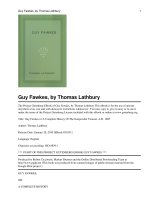A little history of religion
Bạn đang xem bản rút gọn của tài liệu. Xem và tải ngay bản đầy đủ của tài liệu tại đây (2.75 MB, 256 trang )
Tai Lieu Chat Luong
ALITTLEHISTORYOFRELIGION
AlsobyRichardHollowayLetGodArise(1972)
NewVisionofGlory(1974)
ANewHeaven(1979)
BeyondBelief(1981)
SignsofGlory(1982)
TheKilling(1984)
TheAnglicanTradition(ed.)(1984)ParadoxesofChristianFaithandLife(1984)TheSidelongGlance
(1985)
TheWayoftheCross(1986)SeventoFlee,SeventoFollow(1986)Crossfire:FaithandDoubtinanAgeof
Certainty(1988)TheDivineRisk(ed.)(1990)AnotherCountry,AnotherKing(1991)WhoNeeds
Feminism?(ed.)(1991)Anger,Sex,DoubtandDeath(1992)TheStrangerintheWings(1994)Churches
andHowtoSurviveThem(1994)BeholdYourKing(1995)
LimpingTowardstheSunrise(1996)DancingontheEdge(1997)
GodlessMorality:KeepingReligionoutofEthics(1999)DoubtsandLoves:WhatisLeftofChristianity
(2001)OnForgiveness:HowCanWeForgivetheUnforgivable?(2002)LookingintheDistance:The
HumanSearchforMeaning(2004)HowtoReadtheBible(2006)BetweentheMonsterandtheSaint:
ReflectionsontheHumanCondition(2008)LeavingAlexandria:AMemoirofFaithandDoubt(2012)
Copyright©2016RichardHollowayAllrightsreserved.Thisbookmaynotbereproducedinwholeorin
part,inanyform(beyondthatcopyingpermittedbySections107and108oftheU.S.CopyrightLawand
exceptbyreviewersforthepublicpress)withoutwrittenpermissionfromthepublishers.
For information about this and other Yale University Press publications, please contact: U.S. Office:
yalebooks.com
EuropeOffice:yalebooks.co.uk
Set in Minion Pro by IDSUK (DataConnection) Ltd Printed in Great Britain by TJ International Ltd,
Padstow,CornwallLibraryofCongressCataloging-in-PublicationDataNames:Holloway,Richard,1933author.
Title:Alittlehistoryofreligion/RichardHolloway.
Description:NewHaven:YaleUniversityPress,[2016]
LCCN2016013232|ISBN9780300208832(c1:alk.paper)LCSH:Religions.|Religion—History.
Classification:LCCBL80.3.H652016|DDC200.9—dc23
LCrecordavailableat />AcataloguerecordforthisbookisavailablefromtheBritishLibrary.
10987654321
NickandAlice
Withlove
Contents
1
2
3
4
5
6
7
8
9
10
11
12
13
14
15
16
17
18
19
20
21
22
23
24
IsAnybodyThere?
TheDoors
TheWheel
OneIntoMany
PrincetoBuddha
DoNoHarm
TheWanderer
IntheBulrushes
TheTenCommandments
Prophets
TheEnd
Heretic
TheLastBattle
WorldlyReligion
TheWaytoGo
StirringuptheMud
ReligionGetsPersonal
TheConvert
TheMessiah
JesusComestoRome
TheChurchTakesCharge
TheLastProphet
Submission
Struggle
25 Hell
26 VicarofChrist
27 Protest
28 TheBigSplit
29 Nanak’sReformation
30 TheMiddleWay
31 BeheadingtheBeast
32 Friends
33 MadeinAmerica
34 BornintheUSA
35 TheGreatDisappointment
36 MysticsandMovieStars
37 OpeningDoors
38 AngryReligion
39 HolyWars
40 TheEndofReligion?
Index
CHAPTER1
IsAnybodyThere?
W hatisreligion?Andwheredoesitcomefrom?Religioncomesfromthemind
ofthehumananimal,soitcomesfromus.Theotheranimalsonearthdon’tseem
toneedareligion.Andasfaraswecantelltheyhaven’tdevelopedany.That’s
becausetheyaremoreatonewiththeirlivesthanweare.Theyactinstinctively.
They go with the flow of existence without thinking about it all the time. The
humananimalhaslosttheabilitytodothat.Ourbrainshavedevelopedinaway
that makes us self-conscious. We are interested in ourselves. We can’t help
wonderingaboutthings.Wecan’thelpthinking.
Andthebiggestthingwethinkaboutistheuniverseitselfandwhereitcame
from.Istheresomebodyouttherewhomadeit?Theshorthandwordweusefor
this possible somebody or something is God, theos in Greek. Someone who
thinks there is a god out there is called a theist. Someone who thinks there’s
nobodyoutthereandwe’reonourownintheuniverseiscalledanatheist.And
thestudyofthegodandwhatitwantsfromusiscalledtheology.Theotherbig
questionwecan’thelpaskingourselvesiswhathappenstousafterdeath.When
we die, is that it or is there anything else to come? If there is something else,
whatwillitbelike?
What we call religion was our first crack at answering these questions. Its
answer to the first question was simple. The universe was created by a power
beyonditselfthatsomecallGod,thatcontinuestobeinterestedandinvolvedin
whatithascreated.Theindividualreligionsallofferdifferentversionsofwhat
thepowercalledGodislikeandwhatitwantsfromus,buttheyallbelieveinits
existenceinsomeformorother.Theytelluswearenotaloneintheuniverse.
Beyond us there are other realities, other dimensions. We call them
‘supernatural’becausetheyareoutsidethenaturalworld,theworldimmediately
availabletooursenses.
If religion’s most important belief is the existence of a reality beyond this
worldthatwecallGod,whatpromptedthebeliefandwhendiditstart?Itbegan
ages ago. In fact, there doesn’t seem to have been a time when human beings
didn’t believe in the existence of a supernatural world beyond this one. And
wonderingaboutwhathappenedtopeopleaftertheydiedmayhavebeenwhat
started it off. All animals die, but unlike the others, humans don’t leave their
deadtodecomposewheretheydrop.Asfarbackaswecanfollowtheirtraces,
humansseemtohavegiventheirdeadfunerals.Andhowtheyplannedthemtells
ussomethingabouttheirearliestbeliefs.
Of course, this is not to say that other animals don’t mourn their dead
companions. There is plenty of evidence that many of them do. In Edinburgh
there is a famous statue of a little dog called Greyfriars Bobby that testifies to
thegriefanimalsfeelwhentheylosesomeonetheyareattachedto.Bobbydied
in1872afterspendingthelastfourteenyearsofhislifelyingonthegraveofhis
deadmaster,JohnGray.ThereisnodoubtthatBobbymissedhisfriend,butit
wasJohnGray’shumanfamilywhogavehimaproperfuneralandlaidhimto
restinGreyfriarsKirkyard.Andinburyinghimtheyperformedoneofthemost
distinctivehumanacts.Sowhatpromptedhumanstostartburyingtheirdead?
Themostobviousthingwenoticeaboutthedeadisthatsomethingthatused
tohappeninthemhasstoppedhappening.Theynolongerbreathe.Itwasasmall
steptoassociatetheactofbreathingwiththeideaofsomethingdwellingwithin
yetseparatefromthephysicalbodythatgaveitlife.TheGreekwordforitwas
psyche,theLatinspiritus,bothfromverbsmeaningtobreatheorblow.Aspirit
orsoulwaswhatmadeabodyliveandbreathe.Itinhabitedthebodyforatime.
Andwhenthebodydieditdeparted.Butwherediditgo?Oneexplanationwas
thatitwentbacktotheworldbeyond,thespiritworld,theflipsideoftheonewe
inhabitonearth.
What we discover of early funeral rites supports that view, though all our
distantforebearsleftusaresilenttracesofwhattheymighthavebeenthinking.
Writinghadn’tbeeninvented,sotheycouldn’tleavetheirthoughtsordescribe
theirbeliefsinaformwecanreadtoday.Buttheydidleaveuscluesaboutwhat
theywerethinking.Solet’sstartexaminingthem.Tofindthemwehavetogo
backthousandsofyears BCE,atermthatneedsanexplanationbeforewemove
on.
It makes sense to have a global calendar or way of dating when things
happened in the past. The one we use now was devised by Christianity in the
sixth century CE, showing just how influential religion has been in our history.
For thousands of years the Catholic Church was one of the great powers on
earth, so powerful it even fixed the calendar the world still uses. The pivotal
event was the birth of its founder, Jesus Christ. His birth was Year One.
Anythingthathappenedbeforeitwas BCorBeforeChrist.Anythingthatcame
afteritwasADorannoDomini,theyearoftheLord.
In our time BC and AD were replaced by BCE and CE, terms that can be
translated with or without a religious twist: either Before the Christian Era for
BCEandwithintheChristianErafor CE,orBeforetheCommonErafor BCEor
within the Common Era for CE. You can take your pick as to how you
understand the terms. In this book I’ll use BCE to locate events that happened
BeforeChristorBeforetheCommonEra.ButtoavoidclutteringthetextI’llbe
moresparinginmyuseofCEandwillonlyuseitwhenIthinkit’snecessary.So
if you come across a date on its own you’ll know it happened within the
ChristianorCommonEra.
Anyway,wefindevidencefromabout130000 BCEonwardsofsomekindof
religious belief in the way our ancestors buried their dead. Food, tools and
ornaments were placed in the graves that have been discovered, suggesting a
belief that the dead travelled on to some kind of afterlife and needed to be
equippedforthejourney.Anotherpracticewasthepaintingofthebodiesofthe
dead with red ochre, maybe to symbolise the idea of continuing life. This was
discoveredinoneoftheoldestknownburials,ofamotherandchildatQafzehin
Israelin100000 BCE.Andthesamepracticeisfoundhalfaworldaway,atLake
MungoinAustraliain42000BCE,wherethebodywasalsocoveredinredochre.
Painting the dead marks the emergence of one of humanity’s cleverest ideas,
symbolicthinking.There’slotofitinreligion,soit’sworthgettingholdofit.
As with many useful words, symbol comes from Greek. It means to bring
togetherthingsthathadcomeapart,thewayyoumightgluethebitsofabroken
plate together. Then a symbol became an object that stood for or represented
somethingelse.Itstillhadtheideaofjoiningthingsup,butithadbecomemore
complicatedthansimplyglueingbitsofpotterytogether.Agoodexampleofa
symbolisanationalflag,suchastheStarsandStripes.WhenweseetheStars
andStripesitbringstheUSAtomind.Itsymbolisesit,standsinforit.
Symbols become sacred to people because they represent loyalties deeper
than words can express. That’s why they hate to see their symbols violated.
There is nothing wrong with burning a piece of old cloth, but if it happens to
symboliseyournationitmightmakeyouangry.Whenthesymbolsarereligious,
sacredtoaparticularcommunity,theybecomeevenmorepotent.Andinsulting
them can provoke murderous fury. Hold the idea of symbol in your mind
because it will come up again and again in this book. The thought is that one
thing,suchasredochre,standsforanotherthing,suchasthebeliefthatthedead
goontoanewlifeinanotherplace.
Anotherexampleofsymbolicthinkingwasthewayinwhichmarkingwhere
thedeadlaybecameimportant,especiallyiftheywerepowerfulandsignificant
figures. Sometimes they were laid under gigantic boulders, sometimes in
carefully constructed stone chambers called dolmens, which consisted of two
upright stones supporting a large lid. The most dramatic of humanity’s
monuments to the dead are the pyramids at Giza in Egypt. As well as being
tombs,thepyramidsmightbethoughtofaslaunchpadsfromwhichthesoulsof
theirroyaloccupantshadbeenblastedintoimmortality.
Intimeburialritesbecamenotonlymoreelaborate,butinsomeplacesthey
became frighteningly cruel, with the sacrifice of wives and servants who were
sentalongtomaintainthecomfortandstatusofthedeceasedintheirlifeonthe
otherside.Itisworthnotingthatfromthebeginningtherewasaruthlesssideto
religionthathadlittleregardforthelivesofindividuals.
Agoodreadingofthesecluesisthatourforebearssawdeathastheentrance
toanotherphaseofexistence,imaginedasaversionofthisone.Andwecatcha
glimpseoftheirbeliefinaworldbeyondthisone,yetconnectedtoit,withdeath
asthedoorbetweenthem.
Sofarreligiousbeliefslookasiftheymighthavebeenacquiredbyaprocess
ofinspiredguesswork.Ourancestorsaskedthemselveswheretheworldcame
from and figured it must have been created by a higher power somewhere out
there. They looked at the unbreathing dead and decided their spirits must have
leftthebodiestheyonceinhabitedandgonesomewhereelse.
Butanimportantgroupinthehistoryofreligiondon’tguesstheexistenceof
the world beyond or the destination of departed souls. They tell us they have
visiteditorbeenvisitedbyit.Theyhaveheardthedemandsitmakesofus.They
have been commanded to tell others what they have seen and heard. So they
proclaim the message they have received. They attract followers who believe
theirwordsandstartlivingaccordingtotheirteaching.Wecallthemprophetsor
sages.Anditisthroughthemthatnewreligionsareborn.
Then something else happens. The story they tell is memorised by their
followers. At first it is passed on by word of mouth. But in time it is written
downinwordsonpaper.ItthenbecomeswhatwecallHolyScriptureorsacred
writing. The Bible! The Book! And it becomes the religion’s most potent
symbol.Itisaphysicalbook,obviously.Itwaswrittenbymen.Wecantraceits
history.Butthroughitswordsamessagefromtheworldbeyondisbroughtinto
ourworld.Thebookbecomesabridgethatlinkseternitywithtime.Itconnects
thehumanwiththedivine.Thatiswhyitislookeduponwithaweandstudied
withintensity.Anditiswhybelievershateitwhenitisderidedordestroyed.
The history of religion is the story of these prophets and sages and the
movementstheystartedandthescripturesthatwerewrittenaboutthem.Butitis
a subject that is heavy with controversy and disagreement. Sceptics wonder
whethersomeoftheseprophetsevenexisted.Andtheydoubttheclaimsmadein
their visions and voices. Fair enough, but that is to miss the point. What is
beyonddisputeisthattheyexistinthestoriestoldaboutthem,storiesthatstill
carrymeaningforbillionsofpeopletoday.
In this book we’ll read the stories the religions tell us about themselves
without constantly asking whether that was the way things actually happened
backthen.Butbecauseitwouldbewrongtoignorethatquestionentirely,we’ll
spend the next chapter thinking about what was going on when those prophets
and sages saw visions and heard voices. One of those prophets was called
Moses.
CHAPTER2
TheDoors
S ayyoufoundyourselfintheSinaidesertinEgyptonemorningin1300 BCE.
You might come across a bearded barefoot man kneeling before a thorn bush.
Youwatchhimashelistensintentlytothebush.Thenhespeakstoit.Helistens
again. Finally he gets to his feet and strides away with a purposeful air. The
man’snameisMoses,oneofthemostfamousprophetsinthehistoryofreligion
andfounderoftheJewishreligion.Thestorythatwillonedaybewrittenabout
him will say that on this day a god spoke to him from a burning bush and
commanded him to lead a band of slaves out of Egypt into freedom in the
PromisedLandofPalestine.
To you, the observer, the bush is not burning with a fire that does not
consumeitself.Itisablazewithredberries.Andwhileyounoticehowattentive
Mosesisashelistens,youcan’thearwhatisbeingsaidtohimthoughyoucan
makeouthisreplies.Butyouarenotparticularlysurprisedbyanyofthis.Your
little sister has animated conversations with her dolls. And you have a young
cousinwhotalkstoanimaginaryfriendwhoisasrealtohimashisownparents.
Youmayalsohaveheardmentallyillpeoplehavingintenseconversationswith
unseen listeners. So you are used to the idea that there are people who hear
voicesnooneelsecanpickup.
But let’s turn from Moses for the moment and think about the unseen
speakerwhoisaddressinghim.Fixinyourmindtheideaofaninvisiblereality
outside time and space that can communicate directly with human beings. Get
holdofthatthoughtandyouwillhavegraspedthecentralideaofreligion.There
isapowerintheuniversebeyondwhatisavailabletoourphysicalsensesandit
hasmadeitselfknowntospecialpeoplewhoproclaimitsmessagetoothers.For
themomentweareneitheragreeingnordisagreeingwiththatstatement.Weare
justtryingtopinitdown.ThereisaninvisibleforceouttherethatwecallGod
andithasbeenintouch!That’stheclaim.Aswepursuethishistorywe’lllearn
that the different religions all have different versions of this claim and what it
hasbeentryingtotellus.Butmostofthemtakeforgrantedthatit’sthere.And
thattheirformofbeliefisthebestresponsetoitsexistence.
Nowlet’sgobacktoMosesandthinkabouthissideofthatencounterinthe
desert. To you the bush wasn’t on fire nor could you hear the god’s voice
boomingoutofit.SohowcomeMosesfelttheheatoftheflamesandlistenedso
intently to what the voice commanded him to do and did it? Was it only
happeninginsidehishead,whichiswhyyoucouldn’tseewhatwasgoingon?
Orcouldhismindhavebeenintouchwithanothermindthatwasbeyondyour
reachandunderstanding?Ifreligionsstartwithexperiencesinthemindsoftheir
prophets and sages, and if you want to give them a fair hearing and not just
dismiss them as fantasy, then you are going to have to consider whether some
peoplemaybeopentorealitiestherestofusareblindanddeafto.
Apossibleexplanationisthatourmindsoperateontwodifferentlevels,like
aground-floorapartmentwith abasementorcellarunderneath.Weexperience
thedifferencewhenwedream.Duringthedaytheconsciousmindisawakeon
the ground floor, living its planned and ordered life. But when it puts out the
light and goes to sleep at night the door from the cellar opens and fills our
dreamingmindwithjumbledfragmentsofunspokendesiresandforgottenfears.
Soifwecansetasideforthemomentthequestionofwhetherthereismoreto
theuniversethanmeetstheeye,wecanatleastacknowledgethatthereismore
to us than our regular, waking conscious lives. There is an underground
basementinthehumanmindcalledthesubconsciousandwhenwesleepitsdoor
opensandthroughitfloodtheimagesandvoiceswecalldreaming.
Inthehistoryofreligionwewillfindpeoplewhointheirwakinghourshave
thekindofencounterstherestofushaveonlyindreams.Wecallthemprophet
anddreamers,butanotherwaytothinkofthemmightbeascreativeartistswho,
rather than pouring their visions into paintings or novels, are impelled to
translatethemintomessagesthatpersuademillionstobelieveinwhattheyhave
seen and heard. And Moses is a famous example of this mysterious activity.
Somethinggotintouchwithhimfromsomewhereandbecauseofthatmeeting
the history of the Jewish people changed forever. But what was the something
andwherediditcomefrom?Wasitinsidehim?Wasitoutsidehim?Orcouldit
havebeenbothatthesametime?
Taking what happened to Moses in Sinai as an example and using the
metaphorofthedoorbetweenourconsciousandsubconsciousmindstohelpus,
let me suggest an approach that offers three different ways of thinking about
religiousexperience.
Inaneventofthiskindthedoorbetweenthesubconsciousandtheconscious
mind opens. What follows is like a dream. Prophets believe it is coming from
outsidethem,butitisactuallycomingfromtheirownsubconscious.Thevoice
theyhearisreal.Itspeakstothem.Butitistheirownvoice,comingfrominside
theirownmind.That’swhynooneelsecanhearit.
Or it could be that two doors are open in a prophetic experience. The
subconscious or dreaming mind may have access to the supernatural world
beyond.Ifthereisanotherrealityoutthere,oramindbeyondourminds,itisnot
unlikelythatitwouldtrytogetintouchwithus.Whathappenstoprophetsina
revelation is that they encounter that other reality and its mind speaks to their
mind.Andtheytelltheworldwhatithastoldthem.
There’samiddlepositionbetweentheOneDoortheoryandtheTwoDoor
theory.Yes,theremaybetwodoorsinthehumansubconscious.Andthehuman
mind may have genuine encounters with what’s out there. But we know how
unreliable humans are at understanding other human minds, so we should be
wary about the claims they make about their encounters with the divine mind.
Theremaywellbetwodoorsinthehumansubconsciousmind,buttheonethat
opensontotheotherworldisunlikelyevertobecompletelyajar,sowecan’tbe
certainaboutwhattheprophetsclaimtohaveseenandheard.
LetususemydoorsmetaphortolookagainatwhathappenedtoMosesin
thedesertandthethreedifferentapproachestoreligionitsuggests.Ifyoutake
the One Door approach, Moses had a dream that gave him the strength and
resolution to become the liberator of his people from slavery in Egypt, a story
we’ll look at more closely in a later chapter. The experience was genuine. It
happened.Butitcameentirelyfromhissubconsciousmind.Agoodanalogyfor
thisapproachtoreligioncomesfromtheoldmovietheatresIlovedasaboy.In
those days films were imprinted onto reels of celluloid. At the back of the
cinema above the balcony there was a booth from which the pictures were
projectedontothesilverscreenontheoppositewall.Whatwesawfromwhere
wesatwasinfrontofus,butitactuallycamefromthemachinebehindus.One
way to think about religion is as a projection of the fears and longings of our
subconsciousmindontothescreenoflife.Religionseemstobeoutthereandto
have a life of its own. But it actually comes from the depths of our own
imagination.It’sanentirelyhumanproduction.
You can stop there and leave it at that or you can accept most of that
description and step through the idea of the Second Door. Without changing a
detailofthehumansideofreligiousexperience,itispossibletobelievethatit
came from God as well. We couldn’t hear the voice Moses was listening to
becauseitwasacaseofthemindofthegodcommunicatingdirectlytothemind
of Moses. Invisible and inaudible to us, it was a real encounter with another
reality.Wecan’tfullycomprehendtheevent,butwedoseeitsresults.
And a further turn can be given to the idea of the Second Door. Knowing
how easy it is for human beings to misunderstand everyday encounters with
other humans, they should be wary about the claims they make for their
encounterswithGod,andtreatthemwithscepticismandmodesty.Thismeans
weshouldapplyourcriticalfacultiestoreligiousclaimsandnotjusttakethemat
theirownself-evaluation.
So you can be a non-believer, a true believer or a critical believer. As you
thinkaboutthesemattersyoumayevenfindyourselfswitchingfrompositionto
positionovertheyears,asmanydo.I’llleaveyoutomakeupyourownmind
aboutthebestwaytointerpretthestoriesyou’llreadinthisbook.Ortoleavethe
matterundecideduntilthelastpage.Andyoumayevendecidenottodecide,a
positionknownasagnosticism,fromaGreekwordmeaning‘unknowable’.
Sofarwehavebeenthinkingaboutreligioningeneralterms.Nowit’stime
to look at the individual religions in particular. But where to start is an
interesting question, as is what order we should follow. Unlike the history of
scienceorphilosophy,takingastrictlychronologicalapproachtoreligionwon’t
work.Differentthingsweregoingonindifferentplacesatthesametime,sowe
can’t just follow a continuous line of development. We’ll have to zigzag both
chronologicallyandgeographically.
Theadvantageofthatapproachisthatitwillshowushowvariedwerethe
answers the different religions gave to the big questions humanity has been
asking itself since the beginning. The questions may have been the same – ‘Is
thereanybodyoutthere?Andwhathappenstousafterdeath?’–buttheanswers
have been very different. That’s what makes the history of religion so
fascinating.
Thankfullythereseemstobeanobviousstartingpointforourjourney.Ithas
to be with the oldest and in many ways the most complicated of the living
religions,Hinduism.Sowe’llbeginwithIndia.
CHAPTER3
TheWheel
A popular theme in science fiction is the hero who goes back in time to alter
events in the past that had a catastrophic effect on human history. At the
beginningofonestoryatrainishurtlingalongthetrackswithamadbomberon
board.Heblowsthetrainupasitpassesahugedam,causingafloodofwaterto
drownawholecity.Fortunately,asecretgovernmentdepartmenthasperfecteda
wayofsendingpeoplebackintime.Usingitsnewdevice,itgetsanagentonto
thetrainbeforeitleavesthestation,givinghimtwohourstofindthebomberand
disablethebomb.Hesucceedsjustintimeandthecityissaved.Mostofushave
wished we could go back in time like that to delete a message or restrain an
impulse that hurt others and brought us unhappiness. But the law of
consequences (or one thing follows another) takes over and we are stuck with
theresultofwhatwedid.
InHindureligionthisiscalledkarmaorthelawofthedeed.Butitsscopeis
notjustthelifeyouarelivingnow.AccordingtoHinduteaching,yoursoulor
spirithashadmanylivesinthepastbeforeyoucameintotheoneyouaregoing
through at the moment. And you will live many more lives in the future when
thisoneisover.Eachoftheselivesisdeterminedbyhowyouactedintheone
beforeandtheonebeforethatandtheonebeforethat,awaybackintothemists
of antiquity. Just as how you are behaving now will influence the kind of life
you’llgetonthenextturnofthewheel.
WhentheprophetsandsagesofIndialookedintothedistanceandwondered
what happened to human beings when they died, they received a remarkable
answer.Peopledidnotdie,eitherinthesensethattheyceasedtoexistaltogether
or in the sense that they went on as they were into some other kind of life
beyonddeath.No,theycamebacktoearthagaininanotherlifeformdictatedby
theirkarma.Anditmightnotbeasahumanbeing.Thewholeofexistencewasa
greatrecyclingfactoryinwhichthequalityofthelifethatwentthroughthedoor
markedDeathaffectedthestatusofwhatemergedthroughthedoorontheother
sidemarkedRebirth.Thenameofthefactorywassamsāra(meaningwandering
through),becausesoulswerecarriedthroughittotheirnextshapeandthenext.
For good or ill, every action they committed in one life affected the quality of
theirnextappearance.Anditwasnotjustthehumancreaturethatwastrappedin
samsāra. The world itself was subject to the same law of death and rebirth. At
theendofitscurrentcycleofexistenceitwouldfallintoastateofrepose,from
whichitwouldbecalledbackintobeingwhenthetimewasripe.Sothewheel
ofexistenceturnedandturnedandturnedagain.
But they did not think of karma as a punishment devised by some
supernatural inspector of souls. Karma was an impersonal law like gravity, in
which one thing came from another as effect followed cause, like tapping one
dominoandwatchingalltheothersfall.Initswanderingsthroughsamsārathe
soul might get through as many as eight million appearances before it finally
achieved moksha, or release from existence, and lost itself in eternity like a
raindropfallingintotheocean.Andhowtoescapefromtheendlessturningof
thewheelofexistenceandachievesalvationwastheultimatepurposeofHindu
religion.
The technical term for this description of what happens to us after death is
reincarnation. It has been believed in by many communities throughout the
world,butnowherewiththeintensityachievedinIndianreligion.AllthetermsI
used to define it – karma, the law of the deed, samsāra, the wandering of the
soul in search of moksha or release – come from an ancient language called
Sanskrit. It was brought into India by a band of wild invaders from the north.
And it is with their eruption into India around 2000 BCE that we can date the
beginningsofHinduism.
InthefarawaynorthaboveIndiatherewasalongstretchofgrasslandcalled
the Central Asian Steppes. It was rough prairie country, ideal for the kind of
hard-ridingcowboyswhofollowedtheirgrazingcattleinconstantsearchforthe
best pasture. For reasons weare not quitesure of,around thebeginning of the
secondmillenniumBCEthesepeoplebegantomigratefromthesteppesinsearch
of a better life. Many of them rode south into India. They called themselves
compatriots,orAryansintheirownlanguage.Theywereawarlikepeoplewho
drovefastchariots.AndtheysweptinwavesintotheIndusValleyinthenorthwestcornerofthesubcontinent.
Asophisticatedcivilisationalreadyexistedthere.Ithadadvancedsystemsof
art,architectureandreligion.Anditwouldhavepossessedthevicesaswellas
the virtues of all developed societies. It was into this scene that those Aryan
invadersgalloped,andtheymadeupinenergyandcourageforwhattheylacked
in refinement. Another factor that distinguished the invaders from the natives
was that their skins were lighter, and into that difference in skin colour much
would be read that would echo down the centuries to our own time, giving an
uglyringtotheverywordAryan.Buttheraidersbroughtmorethantheirlight
skinsintoIndia.Theyalsobroughttheirgodswiththemandthebeginningsofa
remarkablebodyofreligiousliteraturecalledVedas.
Intheirwrittenform,theVedaswerecomposedbetween1200and1000 BCE
astheAryansentrenchedthemselvesinIndiaanddominateditslife.Knownas
Shruti, or ‘hearing’, the Vedas were understood in two distinct but related
senses.Theirsubstancehadbeenheardoriginallybythesagesofthepastwho
had waited for the meaning of existence to be disclosed to them from beyond.
They were the original hearers, the ones to whom the voices had spoken. And
whattheyhadheardwaslistenedtoagainandagainbytheirdisciplesasitwas
repeated to them by their teachers. In this way the content of the Vedas was
passedondownthecenturies.Readingthemaloudisstillthepreferredmethod
of learning the Hindu scriptures. You won’t find a ‘Bible’ or a ‘Qur’an’ in a
Hindutemple,butyouwillhearitsspokenequivalentintheceremoniesthatare
practisedthere.
Vedameans‘knowledge’.ThewordhasthesamerootastheEnglishwords
‘wit’ and ‘wisdom’. There are four Vedas – the Rig Veda, the Yajur Veda, the
Sama Veda and the Atharva Veda, each of them with four parts. They are
dividedintotheSamhitas,theBrahmanas,theAranyahasandtheUpanishads.
Here’saquickwordaboutthem.TheRigVedaSamhitaistheoldestofthefour
Vedas. It contains over a thousand hymns praising the gods. In religion this
activityiscalled‘worship’,andonewaytothinkofitisasthekindofflattery
powerful rulers are supposed to enjoy, much in the way the British Queen is
addressed as ‘Your Majesty’ and people are expected to bow or curtsy when
theymeether.Here’sanexamplefromtheRigVeda:MakerofAll,exceeding
wise,exceedingstrong,
Creator,Ordainer,highestExemplar…
Yougettheidea.Layitonthick!Andjustasearthlymonarchsenjoyreceiving
gifts as well as being smothered in compliments, so it was with the gods. If
hymns are the flattery we offer the gods, then sacrifices are the gifts that
accompany them. And they have to be presented in careful ceremonies that
requireskilledprofessionalstoconductthem.IntheHindutraditionthepriests
whoconductedthesacrificeswerecalledBrahminsandtheinstructionmanuals
theycompiledtohelpthemwerecalledBrahmanas.
Directoriesofthissortareboringtomostpeople,buttheycanbeobsessively
interestingtoacertainkindofreligiousmind.WhenIwasayoungmanstudying
to be a priest I was fascinated by guides to the rites and ceremonies of the
differentChristiantraditions.TherewasatomethesizeofadoorstepcalledThe
CeremoniesoftheRomanRiteDescribed,aswellasapaleChurchofEngland
versioncalledRitualNotes.Iusedtodipexcitedlyintobothtopictureregiments
of bishops processing slowly into vast cathedrals smothered in the smoke of
sweetincense.ThosebooksweretheBrahmanasofCatholicChristianity.Butit
is not only religious officials who love dressing up and performing elaborate
rituals. Many private clubs and student fraternities have their own secret
traditions,remindersofthehumanneedforsymbolismandceremony.
If, like me, you are more interested in a religion’s inner beliefs than in its
external rituals, then the final stage of Vedic evolution is the one that should
engage your attention. It comes in the Upanishads, written over a period of
about three centuries and completed around 300 BCE. The Upanishads – or
‘sittings near a teacher’ – move the interest away from the performance or
ceremonialsideofHinduismtoitsphilosophicalandtheologicalaspects.Itisin
theUpanishadsthatwefirstcomeacrossthedoctrineofkarmaandsamsārathat
weexploredatthebeginningofthischapter.
Inthenextchapterwe’llexploretheemergenceofsomeofthesedistinctive
Hinduteachingsandthewaytheywereexplained.ButIwanttoendthischapter
by turning to the Hindu response to religion’s other big question. We have
already seen how they answered the question about what happened to us after
death. The answer of the Upanishads was the remarkable doctrine of
reincarnation.Theotherquestionreligionalwaysasksiswhat,ifanything,isout
thereinthedarknessbeyondtheuniverse.Theotherreligionsusuallynamethe
prophets who gave them the answers to these questions and whose name they
take as their own. That’s not how it went in Hinduism. There was no founder
fromwhomthereligiontakesitsname,nosinglefigureitlookedbacktoasits
inspiration. It came from unnamed dreamers in India’s deep past. But while it
may not have kept the names of those early dreamers, it kept what they told
them.
AndintheRigVedaitbeginstoanswerreligion’squestionaboutwhat’sout
there.TohearitwehavetoimagineourselvesbesideacampfireunderthestarstuddedNorthIndianskyasoneoftheirunknownsagespiercesthroughtimeto
thebeginningoftheworldandbeyond.Heischantingratherthanspeakingashe
gazesraptlyintothenight.
Thenwasnotnon-existentnorexistent:there
wasnorealmofair,noskybeyondit.
ThatOneThing,withoutbreath,breathedbyitsownnature:apartfromitwasnothingwhatsoever.
Thegodsarelaterthanthisworld’sproduction.Whoknows,then,whenceitfirstcameintobeing?
Thegodsarelaterthanthisworld’sproduction.Whoknows,then,whenceitfirstcameintobeing?
He,thefirstofthiscreation,whetherheformeditall
ordidnotformit.
Whoseeyecontrolsthisworldinhighestheaven,heverilyknowsit,orperhapsheknowsitnot.
Therearesurprisesinwhatwehearhimchanting.Thereare‘gods’,weare
told,butthey‘arelaterthanthisworld’sproduction’.Thatmeansthatthey,like
us,weremadeandarealsosubjecttotherevolutionsofthewheeloftime.They
comeandgoliketherestofus.Butthedreamerhintsthatbehindalltheshapeshiftingthereissomethingthatdoesnotchange,‘thatOneThing’hecallsit.It’s
asifhistoryanditscreatureswerelikemiststhatcloakanddistortthepresence
ofagreatmountain:thatOneThing!Butwhatisit?Andwhoarethegodswho
areitsagents?
CHAPTER4









